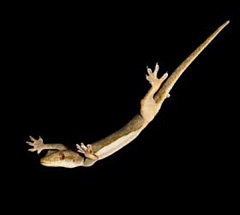
|
 |
 |
 Technology News | March 2008 Technology News | March 2008  
Gecko's Tail Expertise - The Most Advanced Technology In Nature
 Dee Chisamera - eFluxMedia Dee Chisamera - eFluxMedia
go to original


| | This photo of a flat-tailed house gecko skydiving in a wind tunnel was selected for the cover of the March 18, 2008, issue of PNAS. Geckos use their fat-filled tail to right themselves in midair and maneuver to a secure perch. (Robert Full/UC Berkeley) | | |
Super-sticky legs or tail? Tail for the gecko, scientists concluded, as that seems to be the most reliable part of its body in emergency landings. The research conducted by a team of scientists from the University of California, Berkeley is to appear in the online journal Proceedings of the National Academy of Sciences this week.

According to a report published by EurekAlert! (AAAS) of the University of California, Berkeley, the study has two sides to it: the first one is the biological perspective, which gives us a hint on how essential a gecko’s tail is to his impressive midair maneuvers, and the second one is the practical perspective, in other words how its amazing ability could be transposed into technology.

Previous studies failed to find the key element in this relatively small lizard, as the author of the study Robert J. Full highlighted, as they were mostly concentrating on the gecko’s toes rather than tail as key element to support his body on vertical or upside-down horizontal ones.

So the toes are essential to hold on to the surfaces, but they become less effective on slippery surfaces, and that is when the tail comes in: “when put in a slippery patch, we found that they have an active tail that functions like a fifth leg to keep them from tipping backward,” Full said.

Slow motion videos on the gecko’s movement behavior have shown that the tail comes in handy anytime one of the legs loses contact with the surface. The gecko uses its tail to support the body and prevent it from falling until it manages to reposition the leg on the surface.

By using either tail-tapping or tail-flattening techniques, the slippery vertical surfaces are no match for the gecko. “We were really surprised to see that they could pitch back up to 60 degrees, return to the vertical surface and still traverse the slippery patches,” said Ardian Jusufi, who took part in the research.

Scientists have been studying animal behavior in midair twists for more than 100 years, but what makes the gecko so different is the way it uses its tail. While other animals are known to bend or twist their spine for a safe landing, the gecko keeps it straight and simple, by just rotating its tail until it obtains the right balance and position.

“This discovery is another example of how basic research leads to unexpected applications – new climbing and gliding robots, highly maneuverable unmanned aerial vehicles and even energy-efficient control in space vehicles,” Full concluled. | 
 | |
 |



